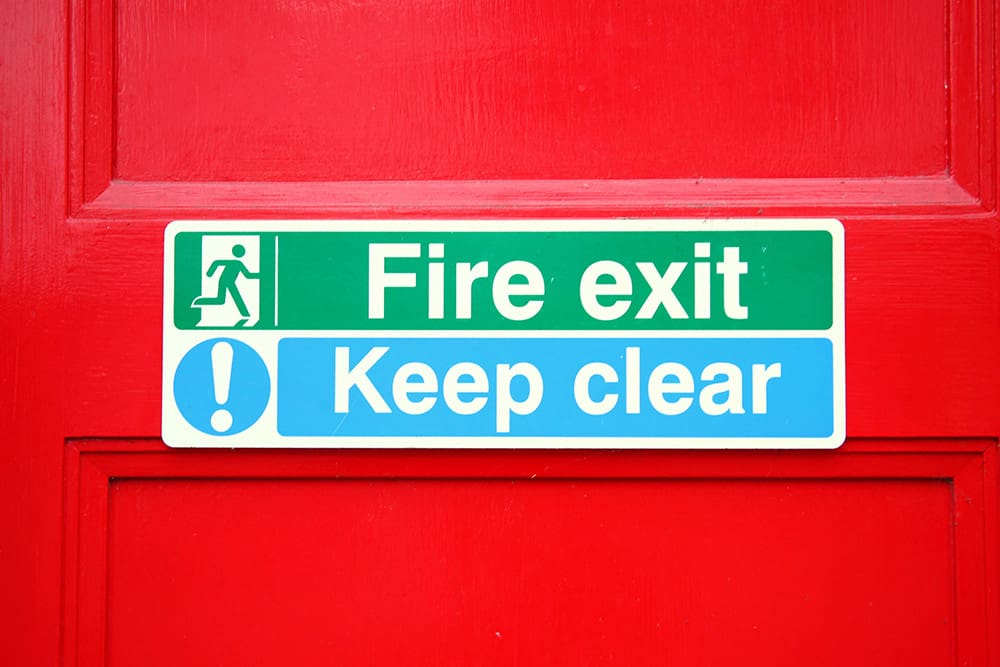
When the topic of fire safety equipment arises, many people think of alarms and extinguishers. While these are important fire-fighting tools, fire doors are also crucial to maintaining fire safety in the workplace. But exactly what is the purpose of a fire door? And does your business need to have fire resisting doors installed?
In this blog, we explain the importance of fire doors, what your legal obligations are and how to make sure your organisation complies with fire safety legislation.
The Crucial Role of Fire Doors
Fire only needs three elements to start: an ignition source, fuel to keep it burning and oxygen. Once ignited, a fire can become uncontrollable in an incredibly short amount of time. On average, fire takes just 30 seconds to accumulate speed and spread exponentially through a building. A fire door is meant to slow down or even prevent this progression from happening.
If a fire does break out, the main purpose of a fire door is to impede the spread of the fire. Once closed, fire doors seal firmly shut, restricting the amount of oxygen that flows to the fire and stopping heat, gases, smoke and flames from spreading to other parts of the building.
At the same time, fire doors still allow people to pass through. They give people a means to evacuate a burning building and provide emergency services access to a burning building. Essentially, they save lives and protect property.
What Are Fire Doors Made From?
Fire doors are made from fire resisting materials such as specially tempered glass, timber, vermiculite boards, gypsum, steel and aluminium.
Many fire doors also have intumescent seals fitted on the sides and the top. These seals expand in size when heated, filling the gaps between the door and the frame and stopping smoke and gas.
Steel fire doors don’t require these types of seals because they naturally expand in a fire, sealing out fire and smoke around the edges.
Fire door windows are made from ceramic glass or borosilicate glass and may be fitted with anti-shatter wire mesh. All fire doors must have a hydraulic or spring-loaded closing mechanism and be fitted with a minimum of three commercial-grade hinges.
Fire doors sold in the UK are tested according to procedures outlined in the standards BS 476 and BS EN 1634 and must be certified by authorised bodies such as the British Woodworking Federation (BWF). The certification label can usually be found at the top edge of the door. Fire doors must also have signage that clearly marks them as fire doors. Fire door signage typically has white writing on a blue background with text such as ‘fire door keep shut’ or ‘automatic fire door’.

How Long Can a Fire Door Withstand Fire?
The length of time that a fire door can withstand fire depends on its rating. There are four types of fire door classifications:
- FD30 – Provides 30 minutes of protection
- FD60 – Provides 60 minutes of protection
- FD90 – Provides 90 minutes of protection
- FD120 – Provides 120 minutes of protection from fire
The fire rating required for your building will depend on its size and nature. Larger, multi-storey buildings with complicated exit routes require fire doors with higher ratings. FD30 and FD 60 are the most common fire doors found in multi-dwelling buildings and commercial premises.
Does Your Business Need Fire Doors?
The Regulatory Reform (Fire Safety) Order 2005 (RRO) mandates that all business premises in the UK must be equipped with fire doors. Fire doors must be positioned in such a way that they provide a clear route to either the outside of a building, a fireproof area on the same floor, or a stairwell that can be used to evacuate the building.
This regulation applies to all buildings solely used for commercial purposes as well as to mixed-use buildings.
Fire doors must also be installed in any domestic dwelling that has more than three storeys and in all blocks of flats and houses in multiple occupation (HMO).
Failure to comply with the regulations of the RRO can result in harsh penalties. Breaches of UK health and safety legislation are considered criminal acts and can be punished by unlimited fines or prison terms.
The Consequences of Having Non-Compliant Fire Doors
The company Beta UK Ltd was charged in 2020, with significant fire safety breaches relating to a blaze at Malik’s Restaurant in Cookham, Berkshire in 2016. Although the fire was found to have been intentionally set by a third party not related to the business, Beta UK Ltd was still prosecuted for failing to adhere to fire safety legislation.
Among other breaches, fire investigators from the Health and Safety Executive (HSE) determined that the company had not installed fire doors that complied with RRO requirements. Beta UK Ltd was fined £85,000 and forced to pay additional court costs.
Fire Safety Obligations for Business Owners
The RRO places obligations upon a ‘responsible person’ to ensure that certain fire safety measures are in place.
These obligations include performing regular assessments to judge the risk of fire, implementing control measures to contain fire risks and ensuring that their premises are fitted with the right fire safety equipment. Business owners must perform regular fire door inspections and conduct fire door maintenance when necessary.
Fire Door Checks Anyone Can Do
To keep your business safe and compliant with the RRO, follow this simple five step check for fire doors:
- Make sure the door has a certification label
- Check the intumescent seals around the door are intact
- Ensure the gaps around the door are less than 4 millimetres
- Make sure the closing mechanism of the door is in working order
- Check that all hinges are firmly affixed to the door
The RRO recognises that business owners cannot be present on the property at all times. The role of ‘responsible person’ can be delegated to a manager or employee, if they are deemed to be competent to perform their duties. Competence is based on if a person has enough knowledge, experience and skill to complete the tasks adequately. Participating in accredited fire safety training will give your people the knowledge they need.
Where to Find Fire Door Safety Training
Human Focus provides an online Fire Door Inspection training that gives supervisors and managers the skills to conduct inspections according to the RRO. Trainees will learn what is the purpose of a fire door, how to check a fire door for faults, and when to arrange fire door maintenance.
The course runs for approximately three hours and can be taken in segments to fit around work schedules. Successful participants will receive a downloadable certificate assured by the Royal Society for the Prevention of Accidents (RoSPA).
Our Fire Door Inspection training course includes a free fire door inspection e-Checklist that can be used for future fire door inspections, as a record of compliance and a record of any maintenance requirements. Sign up today and make sure your business stays fire safe.





























































































































































































































































































































































































































































































































































































































































































































































